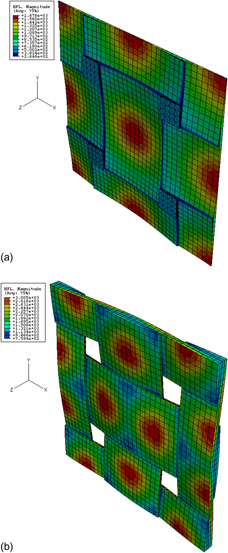Crossref Citations
This article has been cited by the following publications. This list is generated based on data provided by
Crossref.
Li, Hongzhou
Kandare, Everson
Li, Shuguang
Wang, Yongchang
Kandola, Baljinder K.
Myler, Peter
and
Horrocks, A.R.
2012.
Integrated thermal, micro- and macro-mechanical modelling of post-fire flexural behaviour of flame-retarded glass/epoxy composites.
Computational Materials Science,
Vol. 59,
Issue. ,
p.
22.
Li, Hongzhou
Kandare, Everson
Li, Shuguang
Wang, Yongchang
Kandola, Baljinder K.
Myler, Peter
and
Horrocks, A.R.
2012.
Micromechanical finite element analyses of fire-retarded woven fabric composites at elevated temperatures using unit cells at multiple length scales.
Computational Materials Science,
Vol. 55,
Issue. ,
p.
23.
Li, Hongzhou
Fan, Xinyu
and
Yan, Chun
2013.
Prediction of orthotropic mechanical properties of plain‐weave composites with matrix voids using unit cells at multi‐scales.
Polymer International,
Vol. 62,
Issue. 7,
p.
1029.
Qu, Zhaoming
Liu, Shanghe
Wang, Qingguo
Wang, Yilong
and
Wang, Pingping
2014.
Effective permeability of composites containing flaky inclusions with various spatial distributions.
Computational Materials Science,
Vol. 88,
Issue. ,
p.
145.
Gou, Jian-Jun
Dai, Yan-Jun
Li, Shuguang
and
Tao, Wen-Quan
2015.
Numerical study of effective thermal conductivities of plain woven composites by unit cells of different sizes.
International Journal of Heat and Mass Transfer,
Vol. 91,
Issue. ,
p.
829.
Gou, Jian-Jun
Zhang, Hu
Dai, Yan-Jun
Li, Shuguang
and
Tao, Wen-Quan
2015.
Numerical prediction of effective thermal conductivities of 3D four-directional braided composites.
Composite Structures,
Vol. 125,
Issue. ,
p.
499.
Dong, Kai
Liu, Kui
Zhang, Qian
Gu, Bohong
and
Sun, Baozhong
2016.
Experimental and numerical analyses on the thermal conductive behaviors of carbon fiber/epoxy plain woven composites.
International Journal of Heat and Mass Transfer,
Vol. 102,
Issue. ,
p.
501.
Li, Xiaotuo
Yu, Bin
Wang, Pengfei
Zhang, Xin
Fan, Taotao
and
Yang, Jinglei
2017.
Unit cells for thermal analyses of syntactic foams with imperfect interfaces.
Composites Communications,
Vol. 3,
Issue. ,
p.
28.
Gou, Jian-Jun
Gong, Chun-Lin
Gu, Liang-Xian
Li, Shuguang
and
Tao, Wen-Quan
2017.
Unit cells of composites with symmetric structures for the study of effective thermal properties.
Applied Thermal Engineering,
Vol. 126,
Issue. ,
p.
602.
Gou, Jian-Jun
Ren, Xing-Jie
Fang, Wen-Zhen
Li, Shuguang
and
Tao, Wen-Quan
2018.
Two small unit cell models for prediction of thermal properties of 8-harness satin woven pierced composites.
Composites Part B: Engineering,
Vol. 135,
Issue. ,
p.
218.
Li, Shuguang
and
Sitnikova, Elena
2018.
Comprehensive Composite Materials II.
p.
451.
Wei, Kun-long
Li, Jiang
Shi, Hong-bin
and
Tang, Min
2019.
Two-Scale Prediction of Effective Thermal Conductivity of 3D Braided C/C Composites Considering Void Defects by Asymptotic Homogenization Method.
Applied Composite Materials,
Vol. 26,
Issue. 5-6,
p.
1367.
Liu, Y.
Qu, Z.G.
Guo, J.
and
Zhao, X.M.
2019.
Numerical study on effective thermal conductivities of plain woven C/SiC composites with considering pores in interlaced woven yarns.
International Journal of Heat and Mass Transfer,
Vol. 140,
Issue. ,
p.
410.
Penide-Fernandez, Rodrigo
and
Sansoz, Frederic
2019.
Anisotropic thermal conductivity under compression in two-dimensional woven ceramic fibers for flexible thermal protection systems.
International Journal of Heat and Mass Transfer,
Vol. 145,
Issue. ,
p.
118721.
Sun, Zheng
Shan, Zhongde
Shao, Tianmin
and
Zhang, Qun
2020.
Numerical analysis of out-of-plane thermal conductivity of C/C composites by flexible oriented 3D weaving process considering voids and fiber volume fractions.
Journal of Materials Research,
Vol. 35,
Issue. 14,
p.
1888.
Li, Shuguang
and
Sitnikova, Elena
2020.
Representative Volume Elements and Unit Cells.
p.
347.
Hasan, K. M. Faridul
Horváth, Péter György
and
Alpár, Tibor
2021.
Potential fabric-reinforced composites: a comprehensive review.
Journal of Materials Science,
Vol. 56,
Issue. 26,
p.
14381.
Li, Hongzhou
Liu, Chuntai
and
Chen, Jialian
2021.
Predicting and Characterizing Plastic Deformation Behavior of Transversely-isotropic Carbon Fiber Monofilament Using Finite Element Simulation and Nanoindentation.
Fibers and Polymers,
Vol. 22,
Issue. 8,
p.
2316.
Sun, Zheng
Shan, Zhongde
Shao, Tianmin
Li, Jiahua
and
Wu, Xiaochuan
2021.
A multiscale modeling for predicting the thermal expansion behaviors of 3D C/SiC composites considering porosity and fiber volume fraction.
Ceramics International,
Vol. 47,
Issue. 6,
p.
7925.
Li, Hongzhou
and
Chen, Jialian
2021.
Determination of elastic moduli of elastic–plastic microspherical materials using nanoindentation simulation without mechanical polishing.
Beilstein Journal of Nanotechnology,
Vol. 12,
Issue. ,
p.
213.
